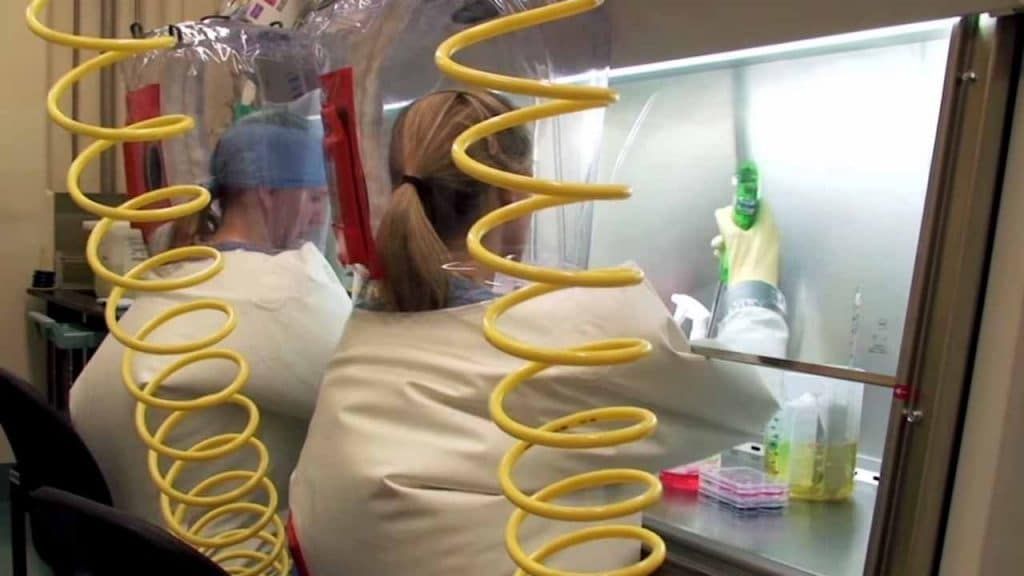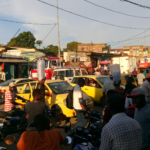Experts know the new coronavirus is not a bioweapon. They disagree on whether it could have leaked from a research lab
By Matt Field | March 30, 2020
 Researchers wearing positive pressure personnel suits at a US National Institute of Allergy and Infectious Diseases biosafety level 4 lab. Credit: National Institute of Allergy and Infectious Diseases.
Researchers wearing positive pressure personnel suits at a US National Institute of Allergy and Infectious Diseases biosafety level 4 lab. Credit: National Institute of Allergy and Infectious Diseases.
Much remains uncertain about the new coronavirus. What treatments will prove effective against COVID-19? When will a vaccine for the disease be ready? What level of social distancing will be required to tame the outbreak, and how long will it need to last? Will outbreaks come in waves? Amid all these vital forward-looking questions remains a more retrospective but still important one: Where did SARS-CoV-2, the virus that causes COVID-19, come from in the first place? Experts seem to agree it wasn’t the product of human engineering. Much research has been focused on the hypothesis that bats passed a virus to some intermediate host—perhaps pangolins, scaly ant-eating mammals—which subsequently passed it to humans. But the pangolin theory has not been conclusively proven. Some experts wonder whether a virus under study at a lab could have been accidentally released, something that’s happened in the past.
Among the latest entrants to the debate about the provenance of SARS-CoV-2 are the authors of a March 17 Nature Medicine piece that takes a look at the virus’s characteristics—including the sites on the virus that allow it to bind to human cells. They looked at whether the virus was engineered by humans and present what appears to be convincing evidence it was not. They also considered the possibility that the outbreak could have resulted from an inadvertent lab release of a virus under study but concluded “we do not believe that any type of laboratory-based scenario is plausible.”
Not all experts agree.
Professor Richard Ebright of Rutgers University’s Waksman Institute of Microbiology, a biosecurity expert who has been speaking out on lab safety since the early 2000s, does agree with the Nature Medicine authors’ argument that the new coronavirus wasn’t purposefully manipulated by humans, calling their arguments on this score strong. Ebright helped The Washington Post debunk a claim that the COVID-19 outbreak can somehow be tied to bioweapons activity, a conspiracy theory that’s been promoted or endorsed by the likes of US Sen. Tom Cotton, Iran’s supreme leader, and others.
But Ebright thinks that it is possible the COVID-19 pandemic started as an accidental release from a laboratory such as one of the two in Wuhan that are known to have been studying bat coronaviruses.
Except for SARS-CoV and MERS-CoV, two deadly viruses that have caused outbreaks in the past, coronaviruses have been studied at laboratories that are labelled as operating at a moderate biosafety level known as BSL-2, Ebright says. And, he says, bat coronaviruses have been studied at such labs in and around Wuhan, China, where the new coronavirus first emerged. “As a result,” Ebright says, “bat coronaviruses at Wuhan [Center for Disease Control] and Wuhan Institute of Virology routinely were collected and studied at BSL-2, which provides only minimal protections against infection of lab workers.”
Higher safety-level labs would be appropriate for a virus with the characteristics of the new coronavirus causing the current pandemic. “Virus collection, culture, isolation, or animal infection at BSL-2 with a virus having the transmission characteristics of the outbreak virus would pose substantial risk of infection of a lab worker, and from the lab worker, the public,” Ebright says.
Ebright points out that scientists in Wuhan have collected and publicized a bat coronavirus called RaTG13, one that is 96 percent genetically similar to SARS-CoV-2. The Nature Medicine authors are arguing “against the hypothesis that the published, lab-collected, lab-stored bat coronavirus RaTG13 could be a proximal progenitor of the outbreak virus.” But, Ebright says, the authors relied on assumptions about when the viral ancestor of SARS-CoV-2 jumped to humans; how fast it evolved before that; how fast it evolved as it adapted to humans; and the possibility that that the virus may have mutated in cell cultures or experimental animals inside a lab.
The Nature Medicine authors “leave us where we were before: with a basis to rule out [a coronavirus that is] a lab construct, but no basis to rule out a lab accident,” Ebright says.
Yanzhong Huang, a senior fellow for Global Health at the Council on Foreign Relations, recently wrote an article for Foreign Affairs that is dismissive of conspiracy theories about the origins of the pandemic but also mentions circumstantial evidence that supports the possibility that a lab release was involved. That evidence includes a study “conducted by the South China University of Technology, [that] concluded that the coronavirus ‘probably’ originated in the Wuhan Center for Disease Control and Prevention,” located just 280 meters from the Hunan Seafood Market often cited as the source of the original outbreak.
“The paper was later removed from ResearchGate, a commercial social-networking site for scientists and researchers to share papers,” Huang wrote. “Thus far, no scientists have confirmed or refuted the paper’s findings.”
While vaccines, treatments, and social distancing strategies are critical to fighting the COVID-19 pandemic, figuring out where this new coronavirus originated is, too. “It is reasonable to wonder why the origins of the pandemic matter,” the Nature Medicine authors write. “Detailed understanding of how an animal virus jumped species boundaries to infect humans so productively will help in the prevention of future [animal to people transfer] events. For example, if SARS-CoV-2 pre-adapted in another animal species, then there is the risk of future re-emergence events. In contrast, if the adaptive process occurred in humans, then even if repeated zoonotic transfers occur, they are unlikely to take off without the same series of mutations.”
Kristian Andersen, the lead author of the Nature Medicine piece, did not respond to a request for comment on the article, and W. Ian Lipkin, another of the authors, declined to answer any questions about it. Thomas Gallagher, a virus expert and professor at Loyola University of Chicago, seconded the authors in dismissing the idea that the pandemic could have lab roots. “The authors of the new letter in Nature Medicine are arguing that the SARS-CoV-2 originated in animals, not in a research laboratory,” Gallagher says. “I agree completely with the authors’ statement.”
“Suggesting that SARS-CoV-2 is a purposely manipulated laboratory virus or a product of an accidental laboratory release would be utterly defenseless, truly unhelpful, and extremely inappropriate,” Gallagher says.
Still, lab safety has been a problem in China. “A safety breach at a Chinese Center for Disease Control and Prevention lab is believed to have caused four suspected SARS cases, including one death, in Beijing in 2004. A similar accident caused 65 lab workers of Lanzhou Veterinary Research Institute to be infected with brucellosis in December 2019,” Huang wrote. “In January 2020, a renowned Chinese scientist, Li Ning, was sentenced to 12 years in prison for selling experimental animals to local markets.
And China is hardly the only place to experience such accidents. A USA Today investigation in 2016, for instance, revealed an incident involving cascading equipment failures in a decontamination chamber as US Centers for Disease Control and Prevention researchers tried to leave a biosafety level 4 lab that likely stored samples of the viruses causing Ebola and smallpox. In 2014, the agency revealed that staff had accidently sent live anthrax between laboratories, exposing 84 workers. In an investigation, officials found other mishaps that had occurred in the preceding decade.
Whether a lab accident could have led to the COVID-19 outbreak remains unclear, but making that determination is worthwhile, Ebright says: “Understanding the origin of the outbreak is a crucial step to reduce the risk of future outbreaks.”
Editors note: A previous version of this article implied that Lijian Zhao, a spokesman for China’s Ministry of Foreign Affairs, supported the false conspiracy theory that the coronavirus was a bioweapon. Instead, Zhao made an unfounded allegation that the US Army was involved in beginning the outbreak.
Together, we make the world safer.
The Bulletin elevates expert voices above the noise. But as an independent nonprofit organization, our operations depend on the support of readers like you. Help us continue to deliver quality journalism that holds leaders accountable. Your support of our work at any level is important. In return, we promise our coverage will be understandable, influential, vigilant, solution-oriented, and fair-minded. Together we can make a difference.
Keywords: Coronavirus, essential biosecurity reading
Topics: Biosecurity
















I agree with Ebright that one shouldn’t rule out a laboratory accident as the source. The Nature opinion piece authors are right that the unusual molecular structure of the virus and the randomness in the mutations from the HKU3-1 bat virus suggest no purposeful manipulation for bioweapons use. However, an accident in a disease transmission experiment shouldn’t be dismissed. The Wuhan lab has been conducting experiments for almost 2 decades to understand how the 2003 SARS-CoV jumped to humans and to identify the natural reservoir of the virus. Bat coronaviruses typically bond to bat ACE2 and rarely to human ACE2.… Read more »
Correction: I meant RaTG13 not HKU3-1. I misread the legend on the figure.
What advantage might a deliberate leaker have anticipated –therefore why would any sane person do it?
We know the old dictum: Don’t attribute to malevolence that which can be explained by simple incompetence. All it takes is an accidental spill, a torn shoe cover, a configuration error in the HVAC system, and we’re off to the races. Containment, location, and monitoring need a lot more attention.
No one said it would be a sane person or group.. . but some think person/group/whatever would want to kill off a huge population of global humans and initiate economic disaster, globally to take over the world, over something that for U.S. figures is causing at this point 30x less at minimum projections to 60X less at high end projections of the yearly Influenza cases, which this year is projected at 39,000,000 to 56,000,000 in U.S. compared to 532,879 for Covid 19 and at possible 1/3 of the deaths 24,000 to 62,000 of the regular influenza this year, compared to… Read more »
Because Covid19 IS NOT THE FLU. It is more dangerous and more contagious, therefore, if we didn’t do a lockdown, the numbers would be worse than the flu. The numbers are low because of the lockdown and social distancing.
It seems the theory lab leakage , accidental or deliberate need more study
I don’t think they are implying it was an intentional leak but moresso a lab accident. The most intriguing part to me is the fact that a lab worker/doctor was found guilty selling test animals to meat markets. That could have been a way it became prevalent in humans.
Can I have a source for that report of them being guilty?
Dr Li Ning, an expert in cloning and former director of the State Key Laboratory of Agrobiotechnology, was found guilty of illegally transferring the funds in the form of “investments” to several companies he controlled, though there was no evidence he spent any of the money on himself, the Intermediate People’s Court of Songyuan in northeast China’s Jilin province said in its verdict.
Li was also fined 3 million yuan, while his assistant, Dr Zhang Lei, was sentenced to five years and eight months in prison and fined 200,000 yuan on the same charge.
https://www.google.com/amp/s/amp.scmp.com/news/china/society/article/3044556/chinese-scientist-li-ning-gets-12-years-prison-embezzling-us43
Good points but i disagree with the final statement. We all know that high containment labs need to be better managed as our own side has several more documented instances of accidents/violations than mentioned in this article, human nature being human nature. AI will no doubt help with those matters. But determining the source, assigning blame, matters less than realizing that this will not be the last pandemic. We need to devote our resources into strengthening defenses against pandemics and understanding the thousands of potential human pathogenic viruses, how they work and how to defeat them. This endeavor will not… Read more »
absolutely…and yet we see populism and all the bright side of humanity fully at work … in the other direction
I agree “We all know that high containment labs need to be better managed” and we cannot expect the people working in those labs, and risking causing a pandemic, to be the same people who will suddenly start behaving responsibly. It is laboratories in the USA (and France) that trained some of the scientists in the Wuhan labs working with coronaviruses. There is already too much trust and cooperation! The scientific community needs oversight from people who are not building their careers through the technologies they are claiming to oversee. For example, gain-of-function research on deadly viruses in unsafe laboratories… Read more »
Yes, cooperation with the Chinese scientist is important. But first we have to get over the hurdle of the Chinese government that doesn’t allow for free speech and communication. Until that happens there will always be mysteries.
And US does? It seems far more of a cacophony in place of information, and where information is needed (from the White House), there’s foolhardy podium-love.
This kind of report could so quickly become the source of a conspiracy theory in the hands of “Fox News”!!
However, that does not mean the issue should not be studied. There are already a multitude of conspiracy theories out there on it. You don’t find the truth by worrying that someone might misread the purpose of your search.
Why is finding the root cause or discussing potential causes inconvenient? What if all it is proven to be correct, will it be a conspiracy theory? Does that bother or worry you MORE than understanding who/how is responsible for what the hell is killing people and shutting down the entire world? It’s time for people to drop the partisan and childish comments…
Become a part of the solution instead of just an observer that offers nothing.
A question from a layman…in the lab release scenario, what is the source of the virus that might have been released from a lab? Are the virus samples collected from the wild? If so, aren’t the odds much higher that the initial humans infected were exposed to the naturally occurring virus? What am I missing here?
Nobody really knows if the source was an accidental lab release or if the cycle was entirely natural. The problem with the lab scenario is that the virus may have been introduced to a new species that is local to Wuhan as a result. When viruses are introduced to new species they can evolve differently since different animals have different immune systems. It’s an even bigger problem if it’s an animal that is eaten by people in the area. The bats that carry RaTG13 live in Yunan, some 2000 kms away from Wuhan and was discovered in 2013 by the… Read more »
Samples are collected from the wild. Then those samples can be cultured in the lab and an artificial acceleration of natural mutations can be produced through experimentation. Then new viruses can be selected for new “improved” functions, this filtering can be done through animal testing. There is a huge risk that one of the people working in the lab could become infected. For example, this could happen due to human error, it has happened many times in the past. The above article gives several examples of these mistakes happening e.g. Beijing in 2004
This article mentions the study by Botao Xiao and Lei Xiao entitled “The possible origins of 2019-nCoV coronavirus” as part of the “circumstantial evidence that supports the possibility that a lab release was involved.” The following is stated: ‘’“The paper was later removed from ResearchGate, a commercial social-networking site for scientists and researchers to share papers,” Huang wrote. “Thus far, no scientists have confirmed or refuted the paper’s findings.”” The facts are that this very brief, poor quality paper has not been subjected to the process of peer-review by a scientific journal (or if it has, the world is unaware… Read more »
” However, since we observed all notable SARS-CoV-2 features, including the optimized RBD and polybasic cleavage site, in related coronaviruses in nature, we do not believe that any type of laboratory-based scenario is plausible.”
So all these features are found in nature, but they’re all also part of viruses used in lab research. That’s a terrible argument against a lab-escaped virus.
The line about ResearchGate having removed the South China Institute of technology paper from their site does not appear to be true:
https://www.researchgate.net/publication/332998684_Novel_Bat_Alphacoronaviruses_in_Southern_China_Support_Chinese_Horseshoe_Bats_as_an_Important_Reservoir_for_Potential_Novel_Coronaviruses
It still shows up for me.
That is an entirely different study. Click on hyperlink “study” in the article.
It is obvious Chinese researchers in Wuhan were studying corona viruses for years and isolated at least one that uses the ACE2 receptor as the binding receptor for the virus, the exact same mechanism Covid-19 uses. see this paper-
https://www.ncbi.nlm.nih.gov/pubmed/24172901
The best way I guess is to make inventory of Wuhan bio lab scientists /staff whether they are still alive or not. And if not, the cause of death and date and time of death. Experts say it is important to find Patient 0 so they can understand better COVID19..
Actually lab-escape theory is so far the more widely accepted conspiracy theory. It had been circulating on social media for weeks, and gained considerable visibility following a New York Post article in late February. But there is a lot of scholarly evidence to suggest that coronavirus was not manufactured in the laboratory. Even if the exact source of the disease is not known yet, the virus originally came from wildlife. In the past , these viruses have spread through wild bats that infect another type of animal – an intermediate host – that then spreads it to humans.
So first you make sure to point out the “social media conspiracy theory” to set the stage for what comes next. What comes next is your refutation of the possibility of a lab escape accident, with this statement… “But there is a lot of scholarly evidence to suggest that coronavirus was not manufactured in the laboratory.” That is a textbook example of a strawman argument. The lab escape theory in no way depends upon the virus being a man-made construct. Conclusively proving that the virus was not man-made in no way disproves the lab escape theory. It is a known… Read more »
in case of a lab leak, wound many lab workers be infected?
Why doesn’t anyone talk about the CDC closing down the bioweapons lab at Ft. Detrick for sloppy practices last August (reopened in November). Remarkable coincidence. (See https://www.fredericknewspost.com/news/politics_and_government/military/fort-detrick-laboratory-restored-to-full-operations-after-being-shut-down-by-cdc/article_fcee204f-1493-52fb-ba9b-f80cb00da727.html)
Lab leakage in secured labs outside China has occurred. It happened in Detrick and in Singapore.
We humans are our own worst enemies. What the hell are scientists (anywhere) doing fooling around with viruses that have no benefit to human life? This virus is more dangerous than Chernobyl…it’s probably going to reappear each year until more sensible scientists find a vaccine. It is one thing to have it be an ‘accident’ it is also another having/allowing ‘children’ to play around with viruses when they are too incompetent to handle such tests securely (accident free)…but when they KNEW it was an issue they (Chinese government) then hoarded all the PPE shipments going out of their country…cause they… Read more »
Wuhan was known to collect bats and study their SARS-family viruses. A virus the result of “serial passage” animal breeding would have no trace of genetic modification because it wouldn’t have any. The most damning evidence in favor of lab origin is, ironically, China’s draconian “sanitizing” of the lab after the outbreak began. Circumstantial evidence points to the Wuhan lab, no gene sequencing needed. I’m still looking for proof they were doing GoF research, preferably with a (hypothetical) SARS-CoV-2 ancestor, selecting for transmissibility. They could destroy evidence in the lab; published acadmeic papers, not so easy.